
![]()
|
|
SalemSalem is supposed to have been one of H. P. L.'s primary inspirations for "witch-cursed, legend-haunted Arkham." (He distinguishes between the two in his stories, but as Donovan Loucks has pointed out to me, this does not preclude Salem from being the source of Arkham as well.) I approached on the 114 from Danvers and, upon reaching Salem, managed to get lost a few times before I could find the National Park Service Visitor Center. The Visitor Center is located a block west of Salem Common at the corner of Brown Street and New Liberty Street. Across the street from the Visitor Center, there is a parking garage, where parking is free on the weekends. |
|
| The Visitor Center is quite extensive and includes a number of displays, many free maps and brochures, as well as books and gifts. I picked up their 1997-1999 Visitor Guide and Map and set forth for Derby House. This house is identified by Loucks with Edward Upton Derby's family home in The Thing on the Doorstep. It is an impressive old brick building with many-paned windows. | |
House of the Seven Gables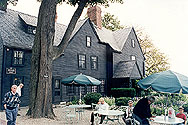
|
I then moved on to the House of the Seven Gables, inspiration for Nathaniel Hawthorne's novel. The guide pointed out that the family name was originally Hathorne, and Nathaniel's great-grandfather was one of the hanging judges during the witch hysteria. Apparently people often asked Nathaniel if he were related to the infamous Judge Hathorne, and he was so embarassed that he changed the spelling of his name. Another interesting point made by the tour guide is that there were no witches in Salem during the hysteria, only innocent people convicted on spurious evidence; but today, ten percent of the population of Salem consists of Wiccans. "Not one witch in 1692, but 3500 witches today." You have to wonder how that happened. The witch trials seem to have had the opposite of their intended effect! The House of the Seven Gables is a clapboarded, many angled structure of a very dark gray, a shade I also saw on other colonial era houses and which makes a rather severe impression. (I assumed that this was paint, but Donovan Loucks informs me that this is actually the natural color of unpainted, weathered wood.) The gardens are very attractive, and the site includes some other places to visit, including the Nathaniel Hawthorne birthplace and an old counting house. After leaving there, I checked out a number of "tourist trap" types of attractions. Salem is the first place I visited that has become so famous as to be actually overly touristy. Many of the shops are of the tacky souvenir type, and some of the commercially run "museums" have appallingly amateurish displays. There are also shops that cater to serious Wiccan and other neo-pagan practitioners, such as Crow Haven Corner, "Purveyor to Witches Around the Globe." |
Salem Witch Museum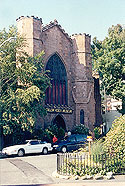 |
Places of some value include the Salem Witch Museum, whose impressively turreted stone facade leers at the passerby off Salem Common. This isn't actually a museum, but a sort of theater. You sit in a dark room where displays depicting various scenes light up one at a time. The narration is interesting and very well done, though the figures in the scenes are rather poor. |
Salem Wax Museum |
The same basic format is used in the Salem Wax Museum, except that here the figures in the scenes are really excellent, but the narration is not quite as good. The focus includes more than the witch trials, beginning with the founding of Salem and its maritime history. |
Old Burying Point Cemetery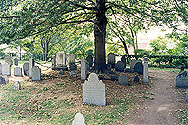
|
Next to the Wax Museum is the Old Burying Point Cemetery, a fairly small and flat one compared to some, but of great age. Some prominently posted signs specified that there is no entry permitted after dark. Do they have problems with covens sneaking in to perform abhorrent rituals at midnight? Beyond that, the Witch Trials Memorial is a small park with stone benches on which are carved the names of all those executed during the witch trials. |
Witch House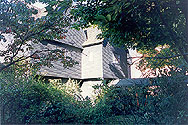 |
There are a couple of good places I missed. The Witch House, another grey-painted colonial structure, was the home not of witches but of witch trial judge Jonathon Corwin. The last tour had just started when I got there around 4:20. The Peabody Essex Museum was highly recommended to me by several people, but unfortunately was closed by the time I got around to it. |
Federal-Style House |
Here are some examples of the antique architecture in town. This a house in the Federal style beloved by Lovecraft. |
Quaint Architecture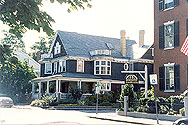 |
I'm not sure what era or style this house represents, but the bow windows and widows walks are quant touches. Something makes me suspect that this is the kind of Victorian frippery that Lovecraft would have found excessive. |
Fanlights
|
Here are a couple of interesting fanlights over doorways; the first is a "spiderweb" fanlight. |
Custom House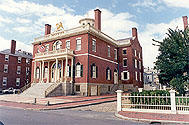 |
This building was used by Hawthorne in the preface to The Scarlet Letter. |
Crowninshield-Bentley House |
On the grounds of the Peabody Essex Museum, at the corner of Essex Street and Washington Square West, is the Crowninshield-Bentley House. Loucks identifies this with the old Crowninshield place in The Thing on the Doorstep, though in the story Lovecraft moved to the house to "the country at the end of High Street" rather than placing it in a downtown area. |
Ropes Mansion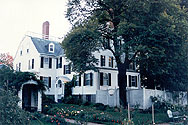 |
As the sky darkened, I walked over to see some of the other old buildings on the map, including Ropes Mansion, Hamilton Hall, and Pickering House. Simply wandering Salem in the dusk can be more rewarding than visiting the official tourist sites. There are many old structures with the atmosphere of bygone days, and quite a few mansions that struck me as worthy of decaying Innsmouth families.
|
A Brick House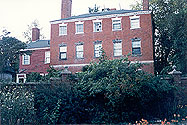 |
This one struck me as being particularly gloomy. |
Church Tower |
I sighted this church tower from a distance, and never learned the name of it. It struck me as a likely abode for the loathsome narrator of The Outsider. |
Old Mansions
|
These mansions struck me as good candidates for use by the decaying old families of Innsmouth. |
Another Old Mansion |
This one actually seems to be frowning. |
Old Burying Point at Dusk
|
A last peek over the fence at the Old Burying Point as the sun went down.
That night I bid farewell to Essex County and moved on to my hotel in Cambridge. |
|
Contents Previous: Danvers Next: Providence Return to Cthulhu Mythos home page Send comments to jfm.baharna@gmail.com © Copyright 1997-2021 by Joseph Morales |
|